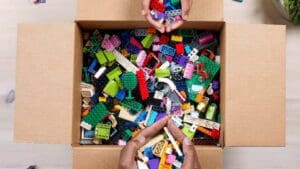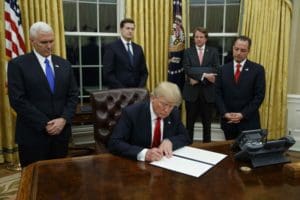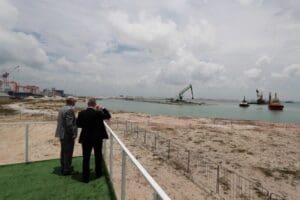 Sustainability has been a really hot topic around here lately. We’ve touched upon ways that companies are reducing their carbon footprint, re-engineering products to include recyclable materials, and using sustainable energy at their factories. But one area that often times goes under the radar is how to re-use consumer goods products that are already out in the market. Lego is tackling this problem head on, and in a very creative way. The company is launching a pilot program to make it easier to donate unwanted Lego bricks. This week, the company unveiled Lego Replay, a program that will provides free shipping labels for donations. Lego will arrange for the bricks to be cleaned, sorted, and delivered to classrooms and after-school programs for needy kids. The program is being tested in the US, but, if successful, could be expanded globally. The impetus was from customer feedback, where many people were looking for an environmentally-friendly reuse for old bricks. Donating old bricks to needy children is certainly better than tossing them in a landfill. And now on to this week’s logistics news.
Sustainability has been a really hot topic around here lately. We’ve touched upon ways that companies are reducing their carbon footprint, re-engineering products to include recyclable materials, and using sustainable energy at their factories. But one area that often times goes under the radar is how to re-use consumer goods products that are already out in the market. Lego is tackling this problem head on, and in a very creative way. The company is launching a pilot program to make it easier to donate unwanted Lego bricks. This week, the company unveiled Lego Replay, a program that will provides free shipping labels for donations. Lego will arrange for the bricks to be cleaned, sorted, and delivered to classrooms and after-school programs for needy kids. The program is being tested in the US, but, if successful, could be expanded globally. The impetus was from customer feedback, where many people were looking for an environmentally-friendly reuse for old bricks. Donating old bricks to needy children is certainly better than tossing them in a landfill. And now on to this week’s logistics news.
- Amazon Prime Air VP touts environmental, safety benefits of drone delivery
- Anheuser-Busch, BYD join for largest Class 8 electric truck deployment
- US blacklists 28 Chinese entities in trade war escalation
- Tuas Port to be world’s largest fully automated terminal when completed in 2040
- Michaels announces UPS partnership
- FedEx, Walgreens look to make online returns easier with new service
- Class I railroads hit with deluge of lawsuits
- Target is going to power Toys R Us’ new website
 During a lunchtime keynote at the GreenTech 2019 conference, hosted by the Environmental Law Institute in Seattle, Amazon Prime Air vice president Gur Kimchi laid out the company’s vision for drone deliveries. Amazon looks at drone deliveries in a few ways. First, especially with all the attention being paid to environmental protection, every drone delivery is “a package not delivered by a car.” Amazon looks at drone deliveries as a way to help protect the environment. The second aspect is a nod to safety; the newest model is a cartwheel-shaped pod that has a range of 7.5 miles and is six feet at its longest point. The design is entirely engineered around making it a safer alternative to other drones in the sky. The third aspect is feasibility. Amazon sees drone deliveries as not only feasible, but also as an economically friendly way for the company to make deliveries. It will be very interesting to monitor this one, as drone deliveries (depending on who you talk to) are about to take off or are still years away.
During a lunchtime keynote at the GreenTech 2019 conference, hosted by the Environmental Law Institute in Seattle, Amazon Prime Air vice president Gur Kimchi laid out the company’s vision for drone deliveries. Amazon looks at drone deliveries in a few ways. First, especially with all the attention being paid to environmental protection, every drone delivery is “a package not delivered by a car.” Amazon looks at drone deliveries as a way to help protect the environment. The second aspect is a nod to safety; the newest model is a cartwheel-shaped pod that has a range of 7.5 miles and is six feet at its longest point. The design is entirely engineered around making it a safer alternative to other drones in the sky. The third aspect is feasibility. Amazon sees drone deliveries as not only feasible, but also as an economically friendly way for the company to make deliveries. It will be very interesting to monitor this one, as drone deliveries (depending on who you talk to) are about to take off or are still years away.
 This Bud’s for you. And its coming from an electric truck. Earlier this week, Anheuser-Busch announced plans to deploy 21 battery electric trucks built by BYD in southern California as part of a state project. Anheuser-Busch and BYD said that the Zero Emission Beverage Handling and Distribution at Scale project represents the largest Class 8 electric truck deployment in North America. Anheuser-Busch will use BYD’s second generation 8TT trucks at distribution facilities in Sylmar, Riverside, Pomona, and Carson. ENGIE Services U.S. will design the charging infrastructure and install a 958.5 kW solar array at the Carson site, which will generate zero-emissions power to offset the use of conventional energy in the charging process.
This Bud’s for you. And its coming from an electric truck. Earlier this week, Anheuser-Busch announced plans to deploy 21 battery electric trucks built by BYD in southern California as part of a state project. Anheuser-Busch and BYD said that the Zero Emission Beverage Handling and Distribution at Scale project represents the largest Class 8 electric truck deployment in North America. Anheuser-Busch will use BYD’s second generation 8TT trucks at distribution facilities in Sylmar, Riverside, Pomona, and Carson. ENGIE Services U.S. will design the charging infrastructure and install a 958.5 kW solar array at the Carson site, which will generate zero-emissions power to offset the use of conventional energy in the charging process.
 With the next round of US – China trade talks looming, the US has taken a bold stance. This time in the ongoing trade war, the US has blocked a group of Chinese technology companies from buying US-made goods on the grounds of alleged human rights abuses in Xinjiang. The 28 Chinese groups include 8 artificial intelligence companies and 20 government entities. According to the US commerce department, these companies have been “targeted for their involvement in human rights abuses against Uighurs and other predominantly Muslim minorities in Xinjiang province.” And while the Chinese foreign ministry criticized the decision, it will still continue with trade talks this week.
With the next round of US – China trade talks looming, the US has taken a bold stance. This time in the ongoing trade war, the US has blocked a group of Chinese technology companies from buying US-made goods on the grounds of alleged human rights abuses in Xinjiang. The 28 Chinese groups include 8 artificial intelligence companies and 20 government entities. According to the US commerce department, these companies have been “targeted for their involvement in human rights abuses against Uighurs and other predominantly Muslim minorities in Xinjiang province.” And while the Chinese foreign ministry criticized the decision, it will still continue with trade talks this week.
 Automation in ports is becoming a necessity as global trade rolls along. It looks like a port in Singapore is set to become the world’s largest fully automated terminal…upon its completion in 2040. When fully completed in 2040, the Tuas mega port will be the world’s largest fully automated terminal, boasting features such as automated wharf and yard functions, and full-electric automated guided vehicles. According to Prime Minister Lee Hsien Loong, during the ground-breaking ceremony this week, “Tuas Port is an opportunity to peer over the horizon and rethink the future of shipping. Because the port will be on a completely greenfield site, we can design from a clean slate and make innovation and sustainability key features. While building the new mega port and its ecosystem is an immense undertaking, it can be achieved if we have the same daring and ambition as our pioneer generation of port planners and engineers.”
Automation in ports is becoming a necessity as global trade rolls along. It looks like a port in Singapore is set to become the world’s largest fully automated terminal…upon its completion in 2040. When fully completed in 2040, the Tuas mega port will be the world’s largest fully automated terminal, boasting features such as automated wharf and yard functions, and full-electric automated guided vehicles. According to Prime Minister Lee Hsien Loong, during the ground-breaking ceremony this week, “Tuas Port is an opportunity to peer over the horizon and rethink the future of shipping. Because the port will be on a completely greenfield site, we can design from a clean slate and make innovation and sustainability key features. While building the new mega port and its ecosystem is an immense undertaking, it can be achieved if we have the same daring and ambition as our pioneer generation of port planners and engineers.”
 The partnership between brick and mortar retail and logistics companies is heating up. On Monday, Michaels said that 1,100 of its stores will now serve as pick-up and drop-off points for UPS. Considering that in total, Michaels has 1,200 stores in the US and Canada, this is a pretty big partnership. Customers can have packages routed to their local Michaels store for delivery and can ship returns from one of its arts-and-crafts stores. This seems to be a direct result of Amazon and Kohl’s expanding their partnership for in-store returns. The announcement has created a rise in Michael’s stock, which has seen a yearlong decline.
The partnership between brick and mortar retail and logistics companies is heating up. On Monday, Michaels said that 1,100 of its stores will now serve as pick-up and drop-off points for UPS. Considering that in total, Michaels has 1,200 stores in the US and Canada, this is a pretty big partnership. Customers can have packages routed to their local Michaels store for delivery and can ship returns from one of its arts-and-crafts stores. This seems to be a direct result of Amazon and Kohl’s expanding their partnership for in-store returns. The announcement has created a rise in Michael’s stock, which has seen a yearlong decline.
 Not to be outdone, FedEx is also expanding a partnership to handle returns as the lines continue to blur between e-commerce and brick and mortar retail. Return label printouts, which are already available at 1,900 FedEx Office locations, will be implemented at thousands of Walgreens stores starting in the next few weeks. Using “FedEx Returns Technology,” online merchants can email a customer a return code, which can be given to a Walgreens store associate, who will print a return label for them. The point is to make the returns process as easy as possible and not require customers to print return labels at home.
Not to be outdone, FedEx is also expanding a partnership to handle returns as the lines continue to blur between e-commerce and brick and mortar retail. Return label printouts, which are already available at 1,900 FedEx Office locations, will be implemented at thousands of Walgreens stores starting in the next few weeks. Using “FedEx Returns Technology,” online merchants can email a customer a return code, which can be given to a Walgreens store associate, who will print a return label for them. The point is to make the returns process as easy as possible and not require customers to print return labels at home.
A few months ago, my colleague Steve Banker wrote an article that outlined how rail customers objected to escalating fines across the country’s seven Class I carriers and referred to monopolistic, unfair, illogical, and arbitrary actions by most of the railroads. On September 30, a deluge of lawsuits hit the four largest Class I railroads. In total, 24 lawsuits were filed against BNSF, CSX, Norfolk Southern, and Union Pacific. The suits came from shippers who alleged wrongdoing in the carriers’ use of fees. In 2007, multiple shippers sued these same four railroads, along with the Association of American Railroads and Kansas City Southern in an antitrust case. In that suit, the shippers claimed that the rail carriers “conspired to fix, raise, maintain, or stabilize prices of unregulated rail freight … by imposing agreed upon Rail Fuel Surcharges.” The multiple lawsuits filed last week are calling for a jury trial. The next step will be for the defendants to respond to the allegations. This will be an interesting case to watch.
 Just in time for the holiday season, Toys R Us is back. Well, at least in online form. Earlier this week, Target made a major announcement: it is partnering with the parent company of the Toys R Us brand, TRU Kids, to help it relaunch ToysRUs.com. The deal enables Toys R Us to have an online presence once again as it attempts to open brick and mortar locations ahead of the holiday season. For Target, this is good news. As the e-commerce site opens, ToysRUs.com shoppers will be re-directed to Target to complete the purchase. Target will then execute the sale and fulfillment of the order. The companies declined to comment on how much of each sale goes to Target versus TRU Kids.
Just in time for the holiday season, Toys R Us is back. Well, at least in online form. Earlier this week, Target made a major announcement: it is partnering with the parent company of the Toys R Us brand, TRU Kids, to help it relaunch ToysRUs.com. The deal enables Toys R Us to have an online presence once again as it attempts to open brick and mortar locations ahead of the holiday season. For Target, this is good news. As the e-commerce site opens, ToysRUs.com shoppers will be re-directed to Target to complete the purchase. Target will then execute the sale and fulfillment of the order. The companies declined to comment on how much of each sale goes to Target versus TRU Kids.
That’s all for this week. Enjoy the weekend, and the song of the week, which just happens to have my favorite Lego-action video, Fell in Love with a Girl, by the White Stripes.
















